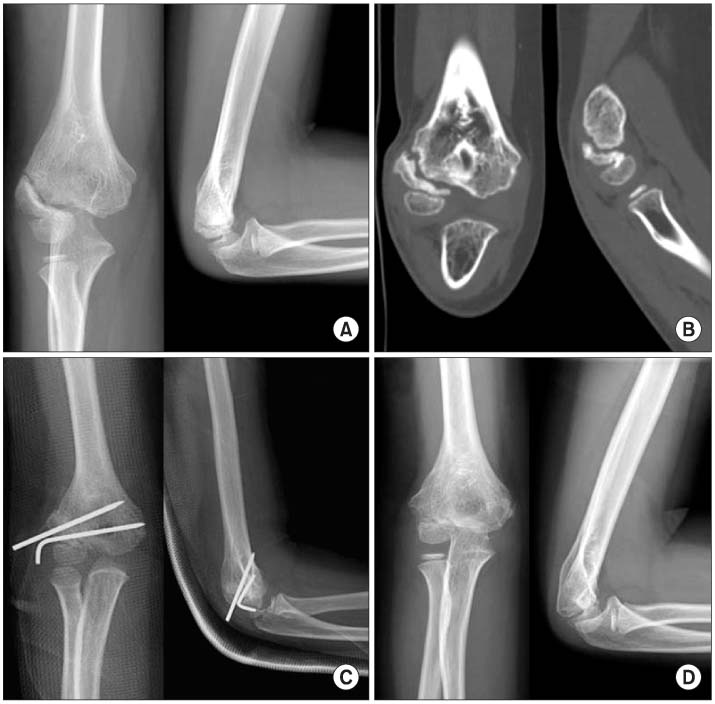J Korean Orthop Assoc.
2010 Aug;45(4):307-313.
Osteosynthesis for Nonunion of the Lateral Condyle of the Humerus
- Affiliations
-
- 1Department of Orthopedic Surgery, The Catholic University of Korea School of Medicine, Seoul St. Mary's Hospital, Seoul, Korea. iyokped@catholic.ac.kr
Abstract
- PURPOSE
Although nonunion of the lateral humeral condyle is a rare complication in children, it can result in a number of complications, and treatment is controversial. Our study shows the results of using osteosynthesis in patients whose lateral humeral condyle was not united. MATERIALS AND
METHODS
We studies 16 patients (M : F=13 : 3; Age: 11.8+/-5.2 years) who were diagnosed with nonunion of the lateral humeral condyle and who underwent osteosynthesis. The mean period of nonunion was 56.2 months (5-132 months). Outcome measures were range of movement, bone union, functional score, and carrying angle and were assessed both before and after surgery.
RESULTS
Bones of all patients were united within 3 months of the operation; there were no complications. After surgery, a decreased range of movement was observed for 3 of 16 patients. However, the functional index for all patients was improved. In other words, the range of movement could be reduced while the functional index was improved so that the deformity would be lessened.
CONCLUSION
Osteosynthesis was successful in repairing the nonunion of the humeral lateral condyle. Therefore, osteosynthesis is suggested for patients who have had no treatment for nonunion of lateral humeral condyle for a long time.
Figure
Reference
-
1. Masada K, Kawai H, Kawabata H, Masatomi T, Tsuyuguchi Y, Yamamoto K. Osteosynthesis for old, established non-union of the lateral condyle of the humerus. J Bone Joint Surg Am. 1990. 72:32–40.
Article2. Marzo JM, d'Amato C, Strong M, Gillespie R. Usefulness and accuracy of arthrography in management of lateral humeral condyle fractures in children. J Pediatr Orthop. 1990. 10:317–321.
Article3. Wadsworth TG. Injuries of the capitular (lateral humeral condylar) epiphysis. Clin Orthop Relat Res. 1972. 85:127–142.
Article4. Kim SS, Kim DH, Lee SW, Kim KH, Sohn SK. Fine classification and treatment outcome of lateral condyle fracture of the humerus in children. J Korean Orthop Assoc. 2005. 40:237–243.
Article5. Yoo CI, Suh JT, Suh KT, Kim YJ, Kim HT, Park WW. A clinical study of the lateral condyle fracture of the humerus in children. J Korean Orthop Assoc. 1993. 28:781–792.
Article6. Yoon HK, Jeon KP, Oh KW, Jung DE, Kang KH, Yoon MS. Clinical study for lateral condyle fracture of humerus in children. J Korean Orthop Assoc. 1994. 29:415–422.
Article7. Toh S, Tsubo K, Nishikawa S, Inoue S, Nakamura R, Narita S. Osteosynthesis for nonunion of the lateral humeral condyle. Clin Orthop Relat Res. 2002. 405:230–241.
Article8. Fontanetta P, Mackenzie DA, Rosman M. Missed, maluniting, and malunited fractures of the lateral humeral condyle in children. J Trauma. 1978. 18:329–335.
Article9. Hardacre JA, Nahigian SH, Froimson AI, Brown JE. Fractures of the lateral condyle of the humerus in children. J Bone Joint Surg Am. 1971. 53:1083–1095.
Article10. Jakob R, Fowles JV, Rang M, Kassab MT. Observations concerning fractures of the lateral humeral condyle in children. J Bone Joint Surg Br. 1975. 57:430–436.
Article11. Flynn JC, Richards JF Jr, Saltzman RI. Prevention and treatment of non-union of slightly displaced fractures of the lateral humeral condyle in children. An end-result study. J Bone Joint Surg Am. 1975. 57:1087–1092.
Article12. Roye DP Jr, Bini SA, Infosino A. Late surgical treatment of lateral condylar fractures in children. J Pediatr Orthop. 1991. 11:195–199.
Article13. Shimada K, Masada K, Tada K, Yamamoto T. Osteosynthesis for the treatment of non-union of the lateral humeral condyle in children. J Bone Joint Surg Am. 1997. 79:234–240.
Article14. Broberg MA, Morrey BF. Results of delayed excision of the radial head after fracture. J Bone Joint Surg Am. 1986. 68:669–674.
Article15. Toh S, Tsubo K, Nishikawa S, Inoue S, Nakamura R, Harata S. Long-standing nonunion of fractures of the lateral humeral condyle. J Bone Joint Surg Am. 2002. 84-A:593–598.
Article
- Full Text Links
- Actions
-
Cited
- CITED
-
- Close
- Share
- Similar articles
-
- Treatment of Fractures of Lateral Condyle of Humerus with Compliations
- The Result After Surgical Treatment on Lateral Condyle Fracture of Humenu in Children
- In Situ Late Metaphyseal Osteosynthesis for the Fractures of the Lateral Humeral Condyle in Children
- Ipsilateral Monteggia Fracture and Lateral Condyle fracture of Humerus in Children
- Surgical Treatment of Late Presented Displaced Lateral Condylar Fracture of the Humerus in Children




